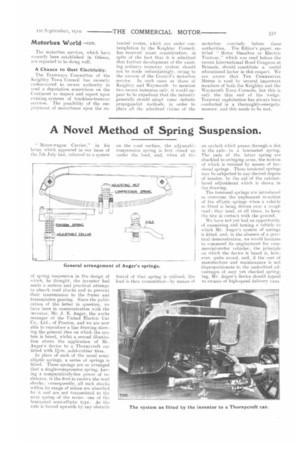A Novel Method of Spring Suspension.
Page 9

If you've noticed an error in this article please click here to report it so we can fix it.
" Motor-wagon Carrier," in his letter which appeared in our issue of the 7th July last, referred to a system
of spring suspension in the design of which, he thought, the inventor had made a serious and practical attempt to absorb road shocks and to prevent their transmission to the frame and transmission gearing. Since the publication of the letter in question, we have been in communication with the inventor, Mr. J. E. Anger, theworks manager of the United Electric Car Co., Ltd., of Preston, and we are now able to reproduce a line drawing showing the general idea, on which the system is based, whilst a second illustration shows the application of Mr. Anger's device to a Thornycroft ear fitted with Win. solid-rubber tires.
In place of each of the usual semielliptic springs, a series of springs is fitted. These springs are so arranged that a single-compression spring, having a comparatively-low power of resistance, is the first to receive the road shocks; consequently; all such 8hock within its range of action are absorbed by it. and are not transmitted to the next spring of the series—one of the laminated semi-elliptic type. As tile axle is forced upwards by any obstacle
on the road surface, the ad justa compression spring is first closed up under the load, and, when all the travel of thal spring is utilized. the load is then transmitted—by means of an eyebolt which passes through a slot • in the axle—to a laminated spring. The ends of the latter spring are shackled to swinging arms, the motion of which is resisted by means of torsional springs. These torsional springs may be subjected to any desired degree of tension, by the aid of the ratchetbleed adjustment which is shown in the drawing. The torsional springs are introduced to overcome the unpleasant re-action of the elliptic springs when a vehicle so fitted is being driven over a rough road : they tend, at all times, to keep the tire in contact with the ground.
We have not yet had an opportunity of examining and testing a vehicle to which Mr. Anger's system of springs is litted, and, in the absence of a practical demonstration, we would hesitate to commend its employment for commercial-motor vehicles ; the principle on which the device is based is, however, quite sound, and, if the cost of manufacture and maintenance is not disproportionate to the undoubted advantages of easy yet checked springing, Mr. Anger's device should appeal to owners of high-speed delivery vans.






















